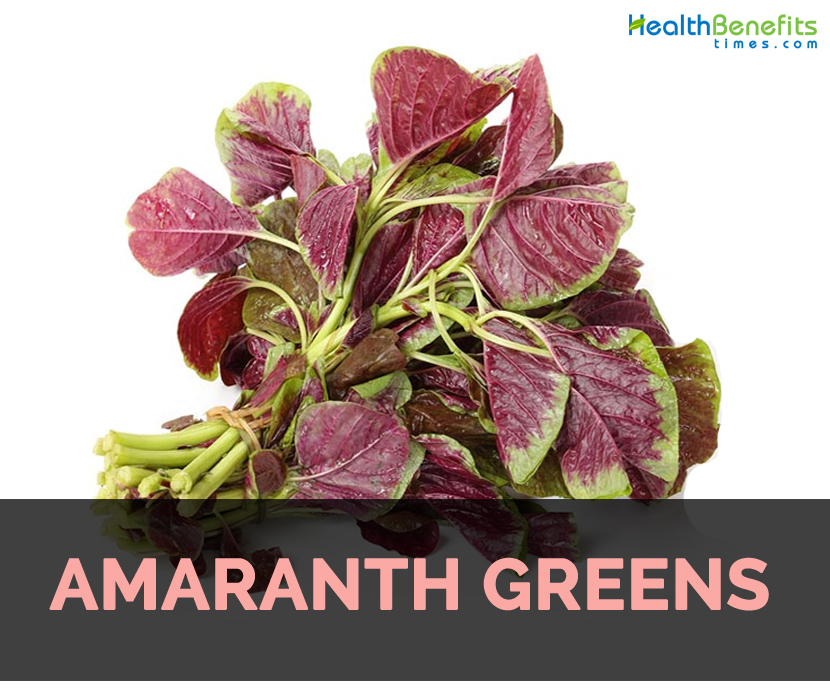| Amaranth greens Quick Facts | |
|---|---|
| Name: | Amaranth greens |
| Origin | Western Central and South America |
| Colors | Purple and red to green or gold |
| Shapes | Round or lance shaped |
| Taste | Slightly astringent, milder |
| Calories | 28 Kcal./cup |
| Major nutrients | Vitamin C (60.33%) Manganese (49.43%) Iron (37.25%) Calcium (27.60%) Vitamin A (26.14%) |
Leaves
Leaves are green or purple with slender stalks and are variable in size. Usually they are alternate, simple having entire margins and distinct markings that depend on species.
Health Benefits of Amaranth greens
- Loaded with nutrients
Amaranth leaves are regarded as storehouse of phytonutrients as well as antioxidants which assist to lower inflammation in the body and boost nutrition to maintain overall health.
- Low calories
The serving of 100 gm of amaranth leaves offers 23 calories. Small bit of fat and no cholesterol content makes it a healthy food for those who are concerned with weight or reduce weight.
- Fiber content
Amaranth leaves have adequate soluble and insoluble fiber that offers various health benefits. Its intake helps to lower weight and hinder heart disease as it reduces cholesterol in blood. Nutritionists recommend to intake high dose of amaranth leaves in diet for managing weight and high blood pressure.
- Treat anemia
A cup of Amaranth leaves offers 29% of daily recommended intake of iron. Iron is required for production of red blood cells and also required for cellular metabolism. Along with amaranth leaves, add vitamin C to facilitate maximum absorption of iron in blood. Add lemon with amaranth leaves with glass of orange juice.
- Strengthen immune system
Amaranth greens have high content of vitamin C. A serving of 100 grams offers 70% of daily requirement of Vitamin C, a water soluble vitamin required to comb at infections and speeds up healing process. It also lowers the effect of free radicals in environment that results in aging and cancer.
- Vitamin A
Amaranth leaves offer adequate Vitamin A. A cup of amaranth leaves provides 97% of daily requirement of this antioxidative vitamin. It is loaded with flavonoid polyphenolic antioxidant such as zeaxanthin, beta carotene and lutein providing a protective layer against oxidative stress caused by free radicals. This vitamin is required for maintaining healthy skin and vision health. It also protects mouth and lung cancers.
- Vitamin K
Amaranth leaves are rich in Vitamin K which is crucial for bone health. It enhances osteoblastic activity and strengthen bone mass. It is useful for people with Alzheimer’s disease as it controls neural damage in brain.
- Vitamin B content
Amaranth leaves are packed with vitamin B group. It offers riboflavin, folates, thiamin, niacin and Vitamin B6. It prevents birth defects in newborn babies and are required for physical and mental health.
- Availability of potassium
Amaranth leaves are loaded with potassium required for maintaining good cardiac health. It is crucial for formation of balanced cellular fluid environment. It controls heart rate in human body.
- Protein
Besides grain, amaranth leaves are also high in protein. Protein through plant source is regarded to be much healthier rather than animal sources as it has no cholesterol and very low fat.
- Presence of lysine
Amaranth leaves contain lysine, an amino acid required for production of energy and calcium absorption. It enhance hair growth and promote skin health. It is beneficial for people experiencing hair loss and graying of hair color.
- Promote HDL cholesterol
Amaranth leaves helps to reduce bad cholesterol which are responsible for cardiac ailments. It lowers high blood pressure and reduces the chances of heart attacks.
- Adequacy of calcium
Amaranth leaves have high calcium content beneficial for people with osteoporosis and other bone associated health problems associated to calcium deficiency.
- Promotes satiety
Intake of amaranth leaves suppress appetite being rich in protein. Diet rich in protein results suppression of hunger as they promote insulin levels in blood and promotes satiety.
- Ease digestion
Amaranth leaves ease the digestion process. It is helpful for treatment of diarrhea and hemorrhages. Its regular intake is found to be helpful for digestive health.
Preparation and serving methods
Isolate leaves and thick stems. Reserve stems to cook separately as it takes longer time to cook. Clean the leaves in cold water before being cooked. Pat them to dry with the use of soft cloth. Chop the leaves and use it for various recipes. Cooking for longer period leads to loss of nutrients such as vitamins and antioxidants.
Serving tips:
- Fresh or tender leaves and shoots are added to salads and juiced.
- Amaranth soup with prepared with ham hocks, taro, celery, peppers, coconut milk, okra and crabmeat.
- In China, it is added to soups and stir-fries.
- Greens are used in stews, curries and mixed vegetable dishes in Indian subcontinent.
- In Greece, Amaranth greens are boiled with other leafy greens such as mustard greens, dandelion and chicory greens dressed with extra virgin oil and squeeze lemon juice.
- Leaves are cooked with lentils and served with rotis or rice.
- In Tamil Nadu, steamed and mashed leaves are sautéed with few spices to make keerai masial.
Safety profile
- Like spinach, amaranth greens contains high oxalic acid which is a naturally occurring substance present in some vegetables that could crystallize as oxalate stones in urinary tract.
- People with oxalate urinary tract stones should avoid intake of vegetables that belongs to Brasscia and Amaranthaceae family.
- The presence of dietary fiber and phytates in leaves could interfere with bioavailability of iron, calcium and magnesium.
- Consume amaranth greens in moderate amounts.
- People allergic to amaranths should avoid it.
- People with lysinuric protein intolerance could experience stomach pain and diarrhea with an intake of amaranth greens.
References:
https://www.nutrition-and-you.com/amaranth-greens.html
https://food.ndtv.com/food-drinks/amaranth-leaves-how-to-cook-this-green-leafy-vegetable-761205
https://www.clovegarden.com/ingred/ch_amaranth.html
https://www.tropicalpermaculture.com/amaranth-plant.html
https://lajollamom.com/amaranth-grain-leaves-health-benefits/
https://extension.umd.edu/sites/extension.umd.edu/files/_docs/EthnicVegHandbook2008.pdf
https://www.nda.agric.za/docs/brochures/amaranthus.pdf
http://www.simplyantioxidant.com/antioxidant-foods-amaranth-greens.html
https://reviewguts.com/amaranth-greens/
https://pharmeasy.in/blog/16-health-benefits-of-amaranth-leave/
Comments
comments
